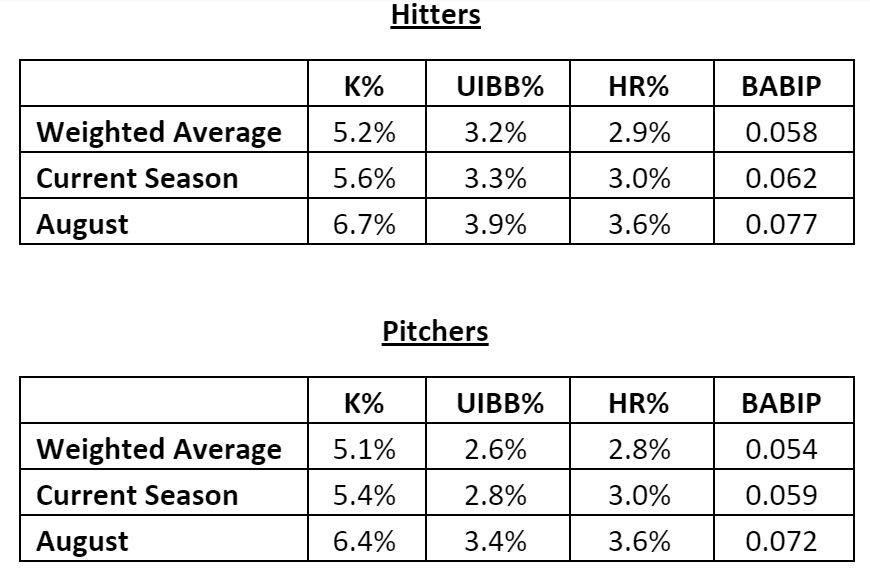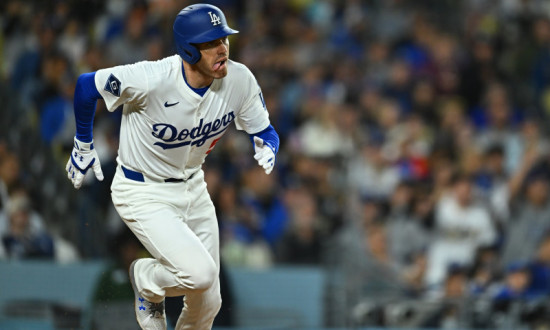Risers and Fallers: Volume 14
I’m excited to be back for another week of Risers & Fallers! Each week, I’ll break down a handful of players using advanced metrics, insights from my scouting background, and my DFS projection system THE BAT (available in the RotoGrinders Marketplace), which consistently beat Vegas lines last year.
I’ll examine guys whose stock is going up, guys whose stock is going down, guys who are perpetually underpriced or overpriced, guys who are worth paying a premium for, or guys who are just interesting and warrant some analysis on. If you guys have any suggestions for who you’d like to see in future articles, feel free to let me know.
Rising… and Overrated
Byron Buxton, Patrick Corbin, Zack Godley, Marwin Gonzalez, Mike Clevinger, Brad Peacock, Chris Taylor, and anyone else having a breakout season or breakout second-half
I can’t believe it’s September already. That means we’re 85% of the way through the season, and there is just one more month of baseball before a long winter. It also means that DFS players are increasingly more likely to make one cardinal mistake: overvaluing current season stats.
Back in April, anyone with a modicum of reason is wary of current season stats and their accompanying small sample sizes. They’ll place at least some emphasis on last season’s stats, and for good reason. After 30 or 40 plate appearances, you absolutely cannot take a player’s performance at face value. But come September, with several hundred plate appearances in the books, it’s very rare to hear touts talk about what a player did last year. After all, 500 plate appearances seems like a lot, it passes most of the magic stabilization points, and most importantly, it’s the most recent data we have. It’s what a player is doing right now. Even worse, some will buy into the last month or so worth of data for a young player that they believe is breaking out (like Byron Buxton or Patrick Corbin right now). Most DFS players find this sufficient, but they’re wrong.
To show why they’re wrong, I ran some quick tests. I looked at the September stats for all players since 1990, and I tried to predict them using three different methods: current-season stats, current-season August stats, and a weighted average of current-season stats and the previous season’s stats (with current season stats weighted more heavily).
Because we’re predicting the future, we will never be able to predict what will happen exactly. We will always be wrong to a certain extent, and the DFS players that predict the future best are those that are wrong by the smallest amount possible. The results below show the average error for each group (or the average amount by which each group is wrong when predicting September stats—smaller is better).

As you can see, for both hitters and pitchers, the group that predicts September stats best—across the board—is the group that uses the current season’s stats mixed with the previous year’s stats. For many, this will be a surprising result, but it shouldn’t be for anyone with an appreciation for math or sabermetrics.
But while current season stats are at least close in terms of accuracy to the weighted average, relying on the absolute most recent stats (August) like some people are currently doing with guys like Buxton and Corbin is a vastly inferior approach.
It’s very easy to get caught up in what is happening right now. It’s very easy to see a player who is having a breakout year and think that he’s finally figured things out and that his past stats don’t matter. But they do. Sure, there will always be outliers that continue playing to their current season stats for months or ever years longer, but these are the exceptions to the rule. In the vast majority of cases, current season stats don’t paint the whole picture, and relying solely on them leads to greater levels of inaccuracy.
This happens literally every year, and yet people continue to trust current season stats as the best approximation of a player talent. They continue to let their cognitive biases eat away at their DFS profits instead of following the math. We’ve already seen the regression monster start to hit players like Aaron Judge, Yonder Alonso, and Jose Berrios. It hasn’t come yet for Buxton or Godley or Corbin or Marwin, but the odds on probability is that it will. The same as it did for Xander Bogaerts and Jackie Bradley Jr. last year. The same as it will for whoever 2018’s Golden Boy is. It’s inevitable.
I realize this is a little mathier than usual, so the bottom line is this: evaluating players based only on current season stats will make you WRONG more often than if you incorporate past season stats as well.
(Nerd Notes: If you’re interested in the specifics of the test methodology, I included all players regardless of sample size. I weighted each player based on the harmonic mean of their plate appearances in September and in the pre-September data. I made no adjustments for parks or context, included no regression or aging effects, just straight up numbers. A projection system that makes these kinds of adjustments (and uses more than just two years) would have a lower average error and be ever more accurate than simply using current-year stats. I did account for the changes in league average over the past 30 years, and simply scaled the results to match the 2017 league average. To create the weighted average of current and previous season, I used the proprietary weight scheme I use for each stat in THE BAT.)

Falling… Temporarily but Legitimately
Freddie Freeman, 1B/3B, Atlanta Braves
I feel really bad for Freddie Freeman. I declared very early in the year that he was a top three hitter in all of baseball and that this fact was hidden by years of playing for crappy Braves teams in an extreme pitchers’ park in Turner Field. With the Braves moving to more hitter-friendly digs in SunTrust Park this season, though, Freeman got off to a scorching start, posting a .484 wOBA with 14 home runs in 165 plate appearances through the middle of May. Then he got injured. He fractured his wrist on May 18, and since returning in early July he has posted a good-but-not-quite-up-to-expectations .376 wOBA with 10 home runs in 240 plate appearances. Over the past couple weeks, Freeman has talked about his wrist not being 100%, which is very common for these types of injuries. Wrist injuries tend to sap power and they tend to linger, sometimes for months after a player returns.
Freeman himself said recently, “There’s no pain. I just have no strength.” He told reporters that he has been swinging a “wet newspaper,” has “nothing left,” and that his “bat speed is absolutely gone.” It’s amazing that he’s put up the numbers he has while going through this, but it does mean that a projection system like THE BAT is going to overrate him, because it’s looking at his incredible historical stats and doesn’t know that he’s playing injured. My current rule of thumb is only to play him in great matchups or when the price makes it impossible to fade.
It’s unfortunate for Freddie, but it does set up a huge value opportunity for the 2018 season. Freeman will have played the majority of 2017 with the injury, and when you look at his final numbers compared to his less-than-elite pre-2017, Turner Field-affected numbers, he may not look like anything special. But when you account for Turner Field and you account for this injury, Freeman is going to be one of the top overall hitters of the 2018 season. He just won’t be priced or treated that way.